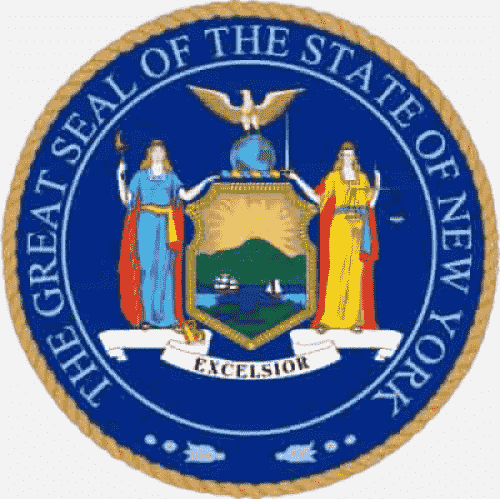 State Flag |  State Seal |
New York is a state in the Northeastern and Mid-Atlantic regions of the United States. It is bordered by New Jersey and Pennsylvania to the south and by Connecticut, Massachusetts, and Vermont to the east.
- ABBREVIATION: NY
- NICKNAME: The Empire State
- POPULATION: 19,867,248 (2024 est.)
- CAPITAL: Albany
- STATE BIRD: Bluebird
- STATE FLOWER: Rose
- AREA: 54,556 sq. mi.
- TIME ZONE: Eastern
- ENTERED UNION: July 26, 1788
- ALTITUDE: High, 5,344 ft. Mount Marcy
- CLIMATE: Cool winters, hot summers in south; cold winters with heavy snow, short summers in north and west. Moderate rainfall.
This state, George Washington predicted, would become the “seat of empire”. The center of an industrial empire it has certainly become. The most populous state in the union, New York is second in the number of manufacturing establishments-over 16,500-beaten only by California. New York produces over $60 billion worth of goods each year.
Over 94% of New York manufacturers are small business companies, adding several hundred-thousand jobs to the workforce.
Cutting through the fertile Mohawk Valley, The Erie Canal in 1825 linked the Great lakes with the vast harbor of New York City by way of the Hudson River. Thus New York City in the middle of the 19th Century became the outlet for beef, wheat, and corn to the Midwest. To the farmers of that rapidly developing region the city shipped their products as well as products of foreign countries.

Statue of Liberty, New York, NY
The harbor of New York City remains a major bulwark of the state’s economy. Considered one of the largest natural harbors in the world, the NYC harbor, by tonnage, is the third busiest harbor in America. In 2010, 4,811 ships entered the harbor, carrying over 32.2 million metric tons of cargo valued at more than $170 Billion.
The city itself is not only the cultural, financial, and communications center of the nation, it is an industrial center as well.
Fun Facts:
- New York is the only state that borders both the Atlantic Ocean and the Great Lakes.
- The Finger Lakes, a series of glacially carved lakes in upstate New York, bear the names of various Native American tribes, including the Seneca, Cayuga, and Canandaigua. The region is second only to California in the production of grapes.
- Adirondack State Park is the largest state park in the country. It is almost as big as Yellowstone, Yosemite, Grand Canyon, and the Olympic National Parks combined.
- The first capital of the United States was New York City. In 1789 George Washington took his oath as president on the balcony at Federal Hall
- The first railroad in America linked Albany and Schenectady running a distance of 11 miles.
- Gennaro Lombardi was the owner of the first pizzeria in the United States. It opened in New York City in 1895.
History:
New York, often called the “Empire State,” has played a central role in the history of the United States. From its Indigenous origins and Dutch settlement to its rise as a cultural and financial powerhouse, New York’s story is one of diversity, transformation, and influence.
Long before European settlers arrived, the land now known as New York was inhabited by Native American tribes, most notably the Iroquois (Haudenosaunee) Confederacy and the Algonquian-speaking Lenape.
The Iroquois, composed of six nations, developed a sophisticated political alliance and inhabited large areas of upstate New York, while the Lenape lived mainly around the Hudson River and modern-day New York City.
In 1609, English explorer Henry Hudson, sailing for the Dutch East India Company, explored the river that now bears his name. This voyage led to Dutch colonization in the region.
In 1624, the Dutch established the colony of New Netherland and soon founded the city of New Amsterdam on the southern tip of Manhattan Island. The Dutch brought commerce, tolerance, and a multicultural spirit, as settlers from many parts of Europe arrived to trade and farm.
In 1664, the British seized control of New Netherland and renamed it New York, in honor of the Duke of York. The colony quickly grew in size and economic power, becoming a major port and trade center. By the 18th century, New York City was one of the most important cities in British North America.
New York played a pivotal role in the American Revolution. The state was the site of major battles, including the Battle of Saratoga in 1777, which was a turning point in the war. New York City was occupied by British forces for much of the war, but the state’s contributions—militarily, politically, and economically—were critical to American independence.
After the Revolution, New York emerged as a national leader. In 1789, George Washington was inaugurated as the first president of the United States in New York City, then the nation’s capital.
The opening of the Erie Canal in 1825 connected the Great Lakes with the Atlantic Ocean via the Hudson River, transforming New York into a commercial hub and accelerating westward expansion.
During the 19th and early 20th centuries, New York became a gateway for immigrants. Ellis Island processed millions of newcomers, and the Statue of Liberty became a symbol of hope and freedom. New York City’s five boroughs were unified in 1898, creating the metropolis known today.
The state has been a leader in finance, industry, arts, and civil rights. Wall Street, the Harlem Renaissance, the United Nations headquarters, and numerous social movements have roots in New York. The state has weathered great challenges, from the Great Depression to the September 11 attacks, and continues to evolve.
Today, New York remains a symbol of American diversity, opportunity, and resilience. Its history is deeply woven into the fabric of the nation—reflecting innovation, conflict, and the enduring spirit of progress.